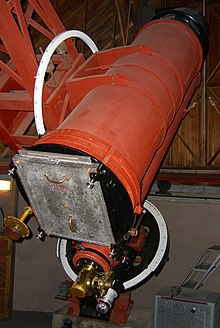When Clyde Tombaugh discovered Pluto, he painstakingly photographed portions of the sky using a 13-inch telescope at Lowell Observatory and compared images from successive nights, looking for objects that showed movement between images. Objects that moved over the course of a night would be within in our solar system.

Mr. Tombaugh used a device called a blink comparator which allows the operator to view two photographic images, rapidly switching between the two. The human eye-brain combination is exceptionally good at seeing changes in the images. Objects that showed movement could be noted for further investigation. Any moving body that appeared where no object was known to exist would be a candidate for an undiscovered asteroids or planet.

After months of systematically photographing the sky and examining the photograhic plates in this way, Mr. Tombaugh recorded a moving object in the location where “Planet-X” was expected by Percival Lowell to be seen. This object was subsequently identified as a new planet and given the name “Pluto.”
As we now know with the benefit of additional decades of observation and analysis, Pluto is better described a a member of a class of objects referred to as Kuiper belt objects, a belt consisting of tens of thousands of objects, similar to the asteroid belt, but extending approximately 30-50 astronomical units from our Sun. So, Clyde Tombaugh really discovered the first object in a whole new class of objects in an unknown region of our solar system. While discovering a new planet is a great achievement in astronomy, reserved for only a few, discovering the first in an entire class of previously unknown objects is far more interesting and, frankly, worthy of greater recognition.
Mr. Tombaugh’s achievement speaks to the great power of carefully defining a question or problem and systematically looking for the answer by careful observation, documentation, analysis and adherence to defensible, logical interpretations of the data. This is the power of science.
Well… it looks like we may have another shot at this. Mike Brown and Konstantin Batygin have hypothesized, based on the the orbital motions of various Kuiper Belt objects, that a large planet, 1o times the mass of Earth may exist in the region of space 20 times farther from the Sun than Neptune. While the hypothesis seems sound and is presented by respected researchers, the methods of science demand proof. So the hunt is on for Planet Nine. Space.com offers the informative infographic below to explain:

It’s doubtful that anyone will use a blink comparator in this search. This technique has long been replaced by computer algorithms that detect motion between images. For visual or demonstration purposes, “blinked” images can readily be created with specialized software packages or even using standard image processing software. An example of an image created from a sequence of several images appears below, similar to a blinked image, showing the movement of Asteroid 2015 TB 145 over the course of a few minutes as it passed by Earth. Note how your eye, after viewing the animation a few times, readily detects the motion of the asteroid relative to the distant star field behind it. A blink comparator depends upon this ability of the human eye-brain combination. Modern computer algorithms look for this sort of motion in very sophisticated ways.

Frankly, it’s also unlikely that a non-professional astronomer will image Planet Nine. Given its hypothesized distance from the earth, it will be an extremely faint object, possibly in the range of magnitude 22 and near aphelion according to Kelly Beatty of Sky and Telescope – probably only within reach of a very powerful telescope, but you never know… It is also hypothesized to be 10 times the mass of Earth – nothing to sneeze at. Although non-professional (a term which I actually prefer to “amateur”) equipment is orders of magnitude more powerful than it once was – comparable to the capabilities of professional observatories in many cases, this object would present a sizeable challenge. If there are some dedicated imagers out there who are up to the challenge, let’s monitor the information on this object as it comes out. Perhaps there will be an opportunity for a citizen science campaign – guess we will have to wait and see. Non-professionals routinely make photometry measurements that imply the presence of planets orbiting other stars. One would think that we could contribute in a meaningful way to the search for a large, albeit distant, planet in our own solar system.